Easy Peasy Help Needed
With zero comments at the last blog post (until early WED morning), I am wondering if folks are getting the Newsletter post notifications. If you received the post notification via e-mail, please be so kind as the RSVP by clicking here and hitting send. Not much effort is required. Thanks.
The Answer to the South Wind Question
Two posts back, I published this:
Conditions Question
Early on a sunny morning in early summer on the east coast of the USA, why is a north wind much better for bird photography than a wind from the south?
Answer
On the east coast in summer, the sun rises well north of east so with a south wind, the birds will be flying, landing, and usually facing away from the light; if you are on sun angle, you will be shooting up their butts. Learn more about the importance of wind direction and speed and how the relationship between sky conditions and wind direction affect flight photography in the just published The Complete and Quintessential Guide to Photographing Birds in Flight. Scroll down for lots more info on this new and comprehensive work.
What’s Up?
With few birds most mornings, and hot, dreary weather conditions, the summer doldrums are here. On the last three mornings, a west wind (bad) came up as the skies cleared early. I have amazed myself by coming away with at least one interesting image that has made me happy each morning. The streak started on Sunday morning with the GBH/siren and preening crane images and continued on Monday with an Osprey bathing at the edge of the lake on a heavily overcast morning. Yesterday, a large mayfly hatch made things interesting and I stayed with a single Snowy Egret for more than 30 minutes. I was eventually rewarded with a single, tight, head-on photo of the bird gulping down a juicy mayfly.
Today is Wednesday 16 July and I will again be heading down to the lake to see if today will be the day that I come up empty. Whatever you opt to do, I hope that you too choose to have a wonderful and productive day and that you have fun too. Do remember that happiness is a choice — Byron Katie, The Work.Com.
If an item — a Delkin flash card, a Levered-clamp FlexShooter Pro, or a Wimberley lens plate — for example, that is available from B&H and/or Bedfords, is also available in the BAA Online Store, it would be great, and greatly appreciated, if you would opt to purchase from us. We will match any price. Please remember also to use my B&H affiliate links or to earn 3% cash back at Bedfords by using the BIRDSASART discount code at checkout for your major gear purchases. Doing either often earns you free guides and/or discounts. And always earns my great appreciation.
Gear Questions and Advice
Too many folks attending BAA IPTs and dozens of photographers whom I see in the field and on BPN, are — out of ignorance — using the wrong gear, especially when it comes to tripods and more especially, tripod heads. And the same is true in spades when ordering new camera bodies or lenses. My advice will often save you some serious money and may help you avoid making a seriously bad choice. Please know that I am always glad to answer your gear questions via e-mail. If you are desperate, you can try me on my cell at 863-221-2372. Please leave a message and shoot me a text if I do not pick up.
Don’t Just Shoot: Learn
If you are interested in changing your life and becoming a better photographer by joining me on an Extended IPT at Sebastian Inlet for Ospreys and more (SEPT 25 to NOV 24, 2025) in San Diego for Pacific-race Brown Pelicans and more (JAN 6 to FEB 2, 2026), for Roseate Spoonbills at Stick Marsh mid-March 2026, please e-mail for dates, rates, terms, and additional information. Or shoot me a text to 863-221-2372. Some offerings include options for shared AirBnB lodging and meals. Ground transportation during your stay is a possibility.
|
|
|
The title says it all. Purchase your copy here. The Complete and Quintessential Guide to Photographing Birds in Flight
|
The Complete and Quintessential Guide to Photographing Birds in Flight
I have long dreamed of becoming a great flight photographer. When using dSLR gear, making sharp images was a huge problem. Most of the time, the camera bodies simply were not up to snuff. Things have changed dramatically with mirrorless technology. The high-end mirrorless camera bodies now feature science fiction-like autofocus systems and frame rates of 30, 40, and even 125 fps. Nowadays, getting the eye sharp is no longer a problem. The problem more often involves selecting the strongest image from a long series of sharp images.
The truth, however, is that there is a lot more than owning a Canon EOS R1, a Nikon Z9, or a Sony a-1 ii to consistently creating great photographs of birds in flight. Some of the biggest factors to success include gear choice, shooting strategies, and understanding the importance of sky conditions and wind speed and direction. Once you have the techniques and technical aspects down pat and can routinely create sharp images, learning the importance of flight poses, wing positions, backgrounds, and subject placement and image design enable you to create and then select superb flight images. And you guessed it, each of those topics and tons more are covered in detail in The Complete and Quintessential Guide to Photographing Birds in Flight.
You can purchase your copy here.
|
|
|
Sample Page #1. Image copyright 2024: Arthur Morris/BIRDS AS ART, the senior author. Page 28 of The Complete and Quintessential Guide to Photographing Birds in Flight |
Sample Page #1
|
|
|
Image copyright 2025: Arash Hazeghi, the junior author. Page 237 of The Complete and Quintessential Guide to Photographing Birds in Flight |
Sample Page #2
The guide consists of 267 pages, 21,013 words with two screen captures. There are 82 illustrative photos scattered throughout the text and a 112-image gallery that includes examples created by Canon, Nikon, and mostly Sony gear. As above, each of the 194 inspirational photos is labeled with an educational caption.
Arash Hazeghi
Arash Hazeghi, Ph.D. is a principal electron device engineer. He received his Ph.D. degree in Electrical Engineering in 2011, from Stanford University, Stanford, California. His pioneering research on Carbon Nanotubes has been cited many times. In the past decade, Arash Hazeghi has been a major contributor to the research and the development of some of the most cutting-edge technologies introduced by Silicon Valley’s most reputable names including SanDisk, Intel and Apple.
More relevant here is that he is widely recognized as one of the world’s best birds in flight photographers. He specializes in raptors and the technical aspects of bird photography.
|
|
|
Flight photography is a skill that can be studied, practiced, and learned. Learn to get better in The Complete and Quintessential Guide to Photographing Birds in Flight |
The Complete and Quintessential Guide to Photographing Birds in Flight
By Arash Hazeghi Ph.D., and Arthur Morris/BIRDS AS ART
What you will learn (about):
-
1- Weight and handholding super-telephoto lenses.
2- Weight and handholding intermediate telephoto and telephotos zoom lenses.
3- Choosing the right flight photography lens or lenses for you.
4- The importance of focal length for flight photography.
5- The importance of lens speed (the maximum aperture for flight photography.
6- Choosing between fixed focal lengths and zoom lenses for flight photography.
7- The importance of AF speed and performance for flight photography.
8- Handholding tips and techniques.
9- Shooting flight off a tripod with the Levered-clamp FlexShooter Pro.
10- Flight poses and wing positions.
11- Why artie changed his mind about the 400mm f/2.8 lenses for flight and more.
12- The advantages and disadvantages of using teleconverters for flight photography.
13- Why to stay away from off-brand lenses.
14- Understanding the importance of wind direction and speed for flight photography.
15- The relationship between sky conditions and wind direction and how it affects flight photography.
16- Creating flight silhouettes in wind-against-sun conditions.
17- The importance of being on sun angle for flight photography (and avoiding harsh shadows).
18- Tips on doing flight photography in cloudy, foggy, or overcast conditions.
19- About the direction of light in cloudy, foggy, or overcast conditions and how it affects flight photography.
20- How your understanding of bird behavior can dramatically improve your flight photography.
21- Tips on attracting birds for flight photography.
22- What to do when your camera’s AF system is temporarily blind.
23- The vital importance of pre-focusing.
24- How Direct Manual Focus can help you with flight photography.
25- The importance of shooting aggressively when doing flight photography.
26- Everything that you need to know with regards to rest positions for flight photography.
27- The importance of getting low when doing flight in many situations.
28- Getting the right exposure when doing flight photography.
29_ Why to use Manual mode 95% of the time for flight.
30- Tips on finding the bird in the frame, acquiring focus, and tracking the bird in flight.
31- How to set and best utilize your lens’s image stabilization feature (and why).
32- Setting the focus range limiter switch on your flight lens or lenses.
33- To choose the best shutter speed for photographing birds in flight.
34- The vital importance of pre-focusing. And yes, this is so important that it is on the list twice.
You can purchase your copy here.
Typos
With all blog posts, feel free to e-mail or to leave a comment regarding any typos or errors.

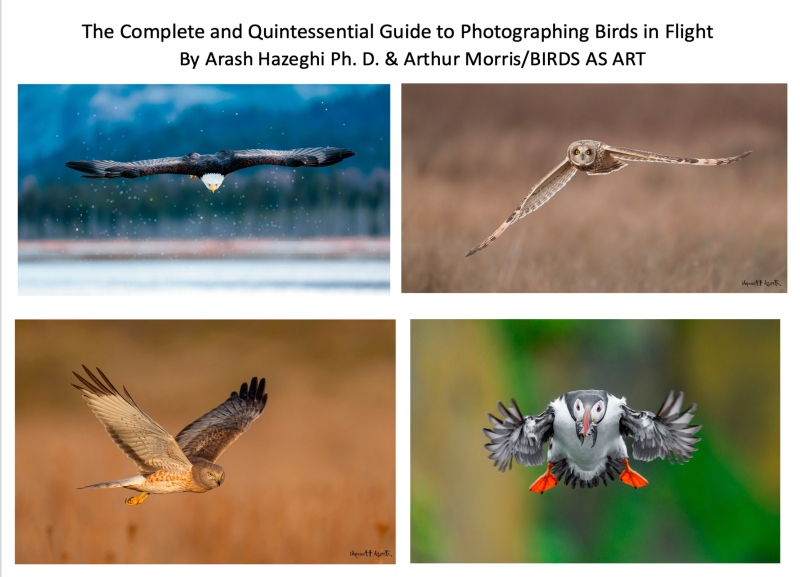
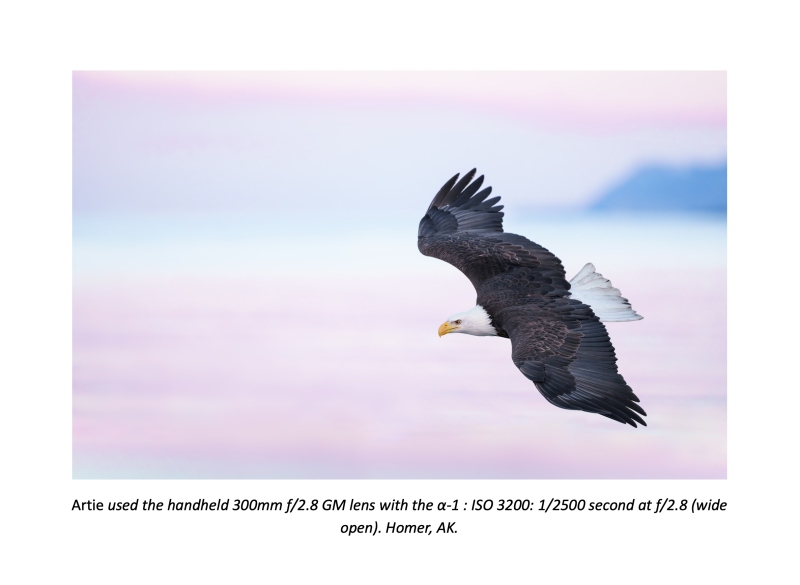
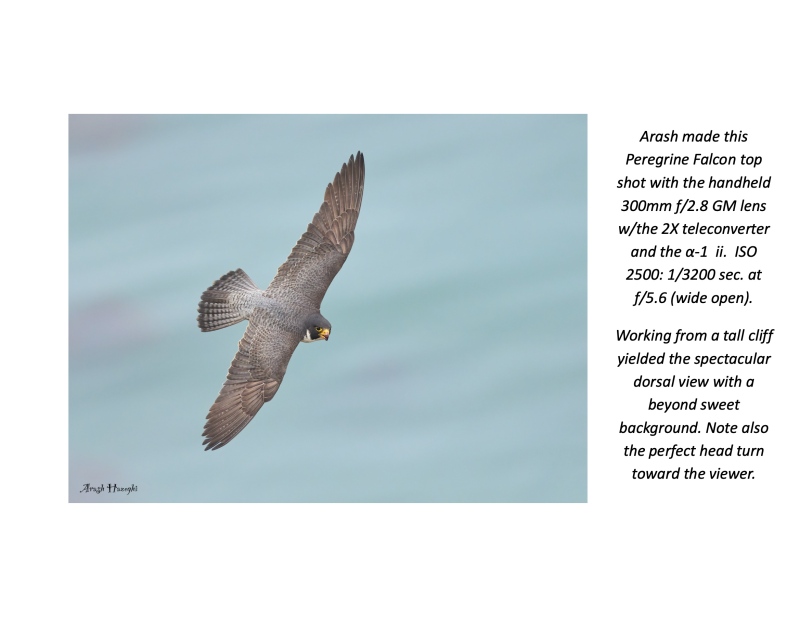
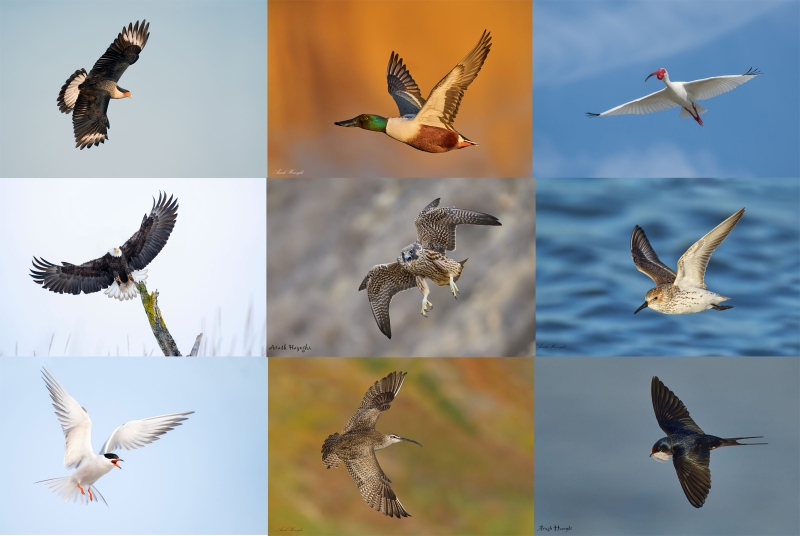









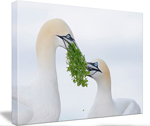



Artie, I am dancing here in Wisconsin to the best I can. I was sitting on the river banks and rewarded with a few sweet Eagle shots. 🙂 only look for one great image and walla poof shutter smashed as I said oh do this and that and yup yup a turn a dive and a fish!
I do not get your blog post email however I saw it in my trash bin this morning even though I have added your email address countless times so I’ll see next time where it lands.
ALWAYS with love b
Thanks East Bobman, Shoot me a JPEG! Tanks on all counts.
with love, a